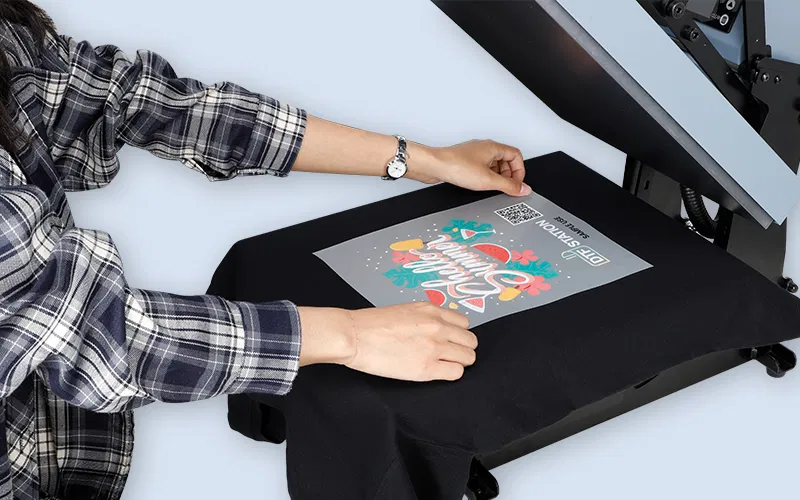What Is Direct-to-Film Printing and How Does It Work?
Direct-to-Film printing, often abbreviated as DTF, is a revolutionary technique that’s reshaping the way apparel designers and manufacturers approach custom garment decoration. Unlike traditional methods, DTF leverages the speed, detail, and customization available through digital technology. The process begins by taking a digital image and printing it onto a special PET (polyethylene terephthalate) film using pigment inks. After printing, an adhesive powder is applied while the ink is still wet, then the film is cured using a heat process to activate the adhesive. Once ready, the film is positioned onto the garment, transferred using a heat press, and then peeled away, leaving a crisp and vibrant design that’s both durable and flexible. The process addresses some of the most daunting challenges faced by apparel decorators—namely, how to deliver intricate, multicolor graphics on demand across a diverse range of fabric types.
What sets DTF apart from alternatives like screen printing or even direct-to-garment (DTG) is its broad appeal and practicality. Screen printing is excellent for high-quantity, single-color runs but struggles when frequent changes or fine detail are needed. DTG requires pretreatment and works best on cotton, while DTF skips the prep work and is unaffected by blends, synthetics, or dark fabrics. These advantages are driving increased interest in DTF Printers, which enable creators to handle both short- and long-run production with spectacular results. Whether you’re an established apparel brand aiming to diversify or a startup seeking a user-friendly entry point, DTF’s blend of quality, speed, and versatility makes it a technology worth exploring.
Key Advantages That Set DTF Apart
One of the primary draws of DTF printing is the flexibility it affords apparel decorators and entrepreneurs. DTF prints retain their brilliance and feel soft on the skin, offering a finish that is both visually stunning and comfortable for everyday wearers. The technology’s compatibility is a significant advantage—applicators can work with a wide range of substrates, including cotton, polyester, tri-blends, performance wear, fleece, canvas, and even unusual materials like denim or spandex. This adaptability enables users to expand their product catalogs and adjust to market fluctuations or customer preferences in real-time.
According to Screen Printing Magazine, DTF technology is playing a key role in the resurgence of U.S.-made apparel, supporting a shift toward local production and reshaping retail with faster turnaround times and reduced reliance on global supply chains.
Environmental consciousness is increasingly influencing buyer behavior and production decisions. Many DTF solutions now utilize water-based inks and eco-friendly adhesive powders to minimize the environmental footprint. With fewer setup requirements and less tolerance for error, DTF is helping businesses deliver on the promise of responsible, on-demand, and high-quality garment decoration.
Mainstream Adoption: The Growth of DTF in Apparel
DTF hasn’t just arrived—it’s taken root as a core technique in the apparel industry. As the need for quick turnarounds and custom small-batch orders grows, so too has the footprint of DTF across fashion, workwear, and branded merchandise sectors. Recent industry data reveal that an increasing number of print providers, decorators, and brand owners are incorporating DTF as either a primary or complementary service, enabling them to adapt to rapidly evolving consumer expectations for personalization and fast delivery. Companies leverage DTF to prototype designs quickly, meet lower minimum-order requirements, and break into markets that demand unique, full-color artwork not well-suited to screen printing.
The widespread adoption of DTF is also boosting entrepreneurship. Startups, artists, and local print shops can compete with major brands by tapping into DTF’s flexibility and reduced upfront costs. According to Hudson Weekly, this accessibility enables even small businesses to produce high-quality prints with fewer resources, thereby helping to level the playing field in the custom apparel space. This democratization of garment decoration technology means more choice for consumers, lower risk for creators, and a richer, more varied array of apparel on the market.
Diverse Applications: Where DTF Shines
- Custom T-Shirts and Streetwear: DTF printing’s “print what you want, when you want” approach is a lifeline for indie brands looking to test new styles or limited-run designs. The result is a flourishing market of creators who set trends rather than follow them.
- Team Uniforms and Sports Apparel: With exceptional stretch, colorfastness, and comfort, DTF excels in the world of athleticwear, delivering consistently sharp graphics that withstand the abuse of repeated washing and on-field play.
- Branded Merchandise for Events and Businesses: Speed and adaptability allow event organizers and businesses to quickly produce branded gear for trade shows, giveaways, or employee kits, meeting tight deadlines without minimal setup time.
- Mixed-Media and Upcycled Fashion Projects: DTF’s compatibility with diverse substrates enables innovative mixed-media clothing and the upcycling of vintage items. Sustainability-focused creators favor DTF to refresh old garments, minimize waste, or blend prints with embroidery, vinyl, or patches.
How to Choose the Right Materials for DTF
Material selection is at the heart of every successful DTF project. The ideal PET film should strike a balance between thickness and heat tolerance, ensuring both easy release and crisp transfer. Choose pigmented, water-based inks to achieve vibrant, fade-resistant colors, but ensure they’re matched to your printer’s technology and textile type. Eco-friendly, low-temperature adhesive powders can be crucial for sensitive fabrics or layered designs. Not all textiles are created equal; for best results, select garments with a tight, smooth weave, which enhances both the detail and durability of the transfer. While DTF is known for its flexibility, fabrics like terry cloth or heavily textured knits may require extra care and experimentation to ensure proper adhesion and optimal image quality.
Steps for Successful DTF Printing Projects
- Artwork Preparation and Color Management: Create designs using software capable of producing high-resolution files, with a clear focus on color profiles (such as CMYK or specialized RIP software for DTF). The more precise your digital file, the better the physical output will be, especially for gradients, small text, or intricate detail.
- Printing and Powder Application: Print the mirrored image onto PET film, then quickly coat it with a uniform layer of adhesive powder, ensuring the powder adheres only where ink has been printed. Shaking off excess powder is essential for avoiding rough patches or inconsistent fusing.
- Curing and Transfer: Properly cure the film using a heat press or conveyor oven. The goal is to melt the adhesive powder without overexposing it to heat. Then, position the film on the garment, using the appropriate time, temperature (commonly 320°F/160°C), and pressure—often 15–20 seconds will suffice for most textiles.
- Finishing and Post-Processing: Allow transfers to cool before peeling the film away, which helps prevent premature lifting or ghosting. Re-pressing briefly with parchment or Teflon after peeling adds softness and increases the bond’s durability.
Common Questions and Troubleshooting Tips
While DTF printing is widely praised for its user-friendliness, even seasoned decorators occasionally encounter issues. If a print cracks or peels after washing, re-examine curing times and temperatures, as insufficient bonding is the primary culprit. For prints that appear faded, double-check color management settings and ensure that the inks are fresh. Tackling static or powder residue? Maintain a clean application area and handle PET film with care to prevent unwanted particles from interfering with adhesion. Finally, always test new materials and setups before moving to large-scale production troubleshooting. A single item is far easier and less costly than correcting. A batch after it has been produced.
Future Trends in DTF Printing
The next generation of DTF offers automation, eco-innovation, and enhanced color controls. Manufacturers are producing machines with automated feeding and powdering capabilities, ideal for lean production lines or businesses scaling up their output. Lower cure temperatures reduce both energy usage and the risk of garment scorch, while new films made from compostable materials are in the works for those seeking a lighter environmental impact. The convergence of DTF with cloud-based workflow tools means order management, print queueing, and even remote troubleshooting continue to get easier and more precise. As highlighted in the latest technology spotlights, these innovations are not only about flashy new features but also about helping brands strike a balance between speed, sustainability, and creativity, all while keeping the end user in mind.
In an era where fashion cycles spin faster than ever and consumers expect instant personalization, DTF printing positions itself as a key enabler of agile, responsive, and eco-minded apparel. Companies and creators investing in this technology are not only adapting to demand but also shaping the future of decorated garments for years to come.
Key Takeaways
- Direct-to-Film (DTF) printing brings adaptability, affordability, and impressive color vibrancy to all facets of apparel decoration.
- Modern DTF technology is more efficient, precise, and sustainable than ever, making high-quality results possible for both small-scale creatives and large production shops.
- From streetwear and sports uniforms to upcycled projects, DTF adapts to various textile applications and evolving customer needs.
- The ability to offer rapid, custom, and small-batch orders reshapes how brands and businesses approach apparel production.








